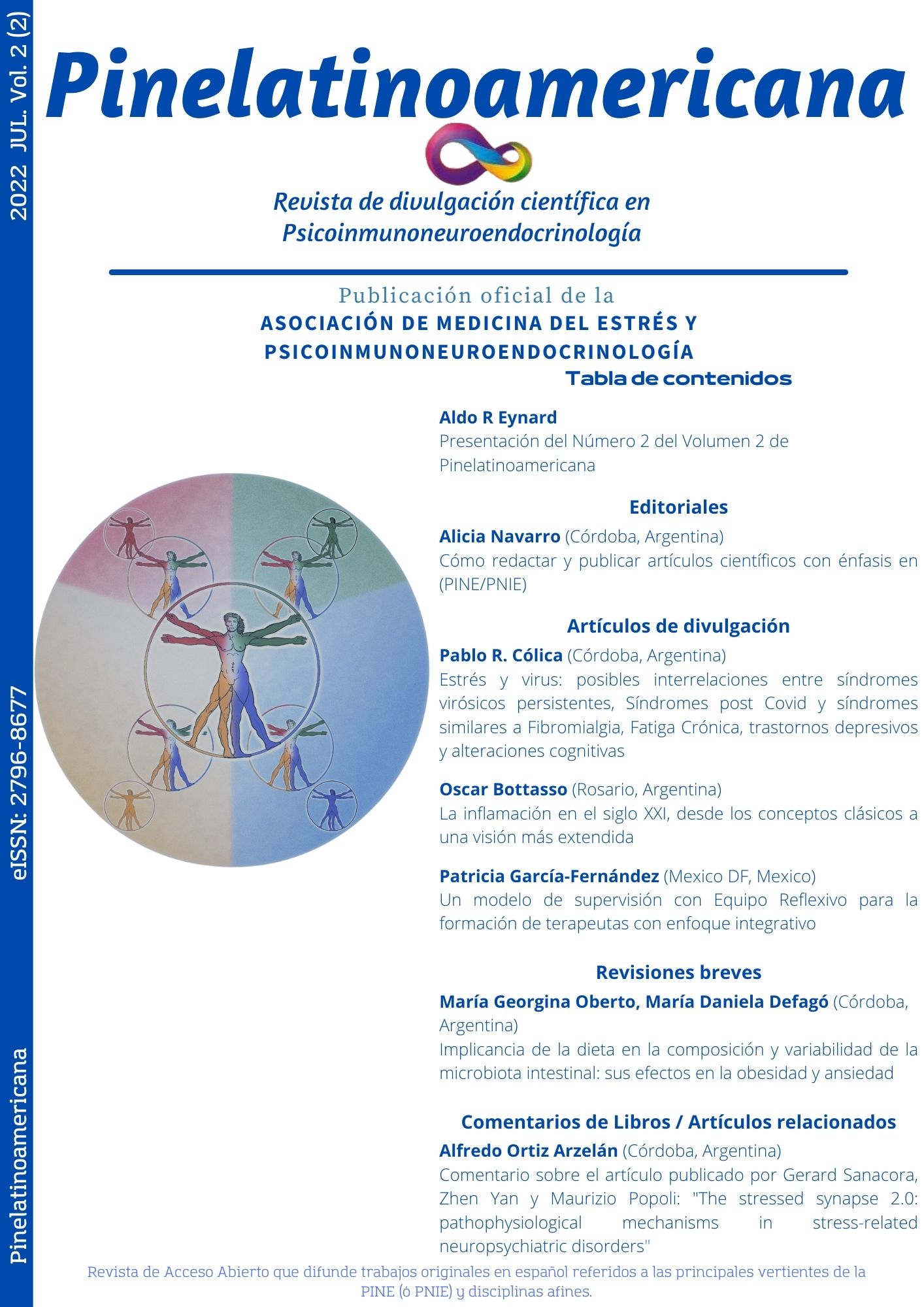Abstract
El artículo hace referencia a los diversos mecanismos disparadores de la respuesta inflamatoria y las consecuencias que suelen darse cuando la noxa no se aclara con perpetuación del proceso; lo cual está ligado a la interconexión entre los grandes sistemas del organismo: inmune, endocrino y del sistema nervioso autónomo. En sintonía con las investigaciones más recientes, también se brinda un nuevo enfoque donde la inflamación viene a constituir una respuesta tendiente a restaurar la homeostasis. Allí se distingue un componente asociado con desviaciones excesivas de procesos celulares, incapaces de ser controlados por los mecanismos reguladores, el cual posee algunas, pero no todas las características de la respuesta clásica: para o metaflamación. Por otro lado, la inflamación tradicional que, si bien puede guardar relación con dicho fenómeno, se entronca particularmente con la respuesta a patógenos, toxinas u otros agentes, no regulables en sí, pero igualmente amenazantes.
Riferimenti bibliografici
Andhavarapu, S., Mubariz, F., Arvas, M., Bever, C., Jr, y Makar, T. K. (2019). Interplay between ER stress and autophagy: A possible mechanism in multiple sclerosis pathology. Experimental and molecular pathology, 108, 183–190. https://doi.org/10.1016/j.yexmp.2019.04.016
Brewer, S. M., Brubaker, S. W., y Monack, D. M. (2019). Host inflammasome defense mechanisms and bacterial pathogen evasion strategies. Current opinion in immunology, 60, 63–70. https://doi.org/10.1016/j.coi.2019.05.001
Dantzer R. (2009). Cytokine, sickness behavior, and depression. Immunology and allergy clinics of North America, 29(2), 247–264. https://doi.org/10.1016/j.iac.2009.02.002
Das, U. N., (2022). Papel de los Lípidos Bioactivos en Psiquiatría, Inmunología, Neurología y Endocrinología (PINE). Pinelatinoamericana, 2(1), 56–81. https://revistas.unc.edu.ar/index.php/pinelatam/article/view/37046
D'Attilio, L., Santucci, N., Bongiovanni, B., Bay, M. L., y Bottasso, O. (2018). Tuberculosis, the Disrupted Immune-Endocrine Response and the Potential Thymic Repercussion As a Contributing Factor to Disease Physiopathology. Frontiers in endocrinology, 9, 214. https://doi.org/10.3389/fendo.2018.00214
Evans, W. J., Morley, J. E., Argilés, J., Bales, C., Baracos, V., Guttridge, D., Jatoi, A., Kalantar-Zadeh, K., Lochs, H., Mantovani, G., Marks, D., Mitch, W. E., Muscaritoli, M., Najand, A., Ponikowski, P., Rossi Fanelli, F., Schambelan, M., Schols, A., Schuster, M., Thomas, D., Wolfe, R y Anker, S. D. (2008). Cachexia: a new definition. Clinical nutrition (Edinburgh, Scotland), 27(6), 793–799. https://doi.org/10.1016/j.clnu.2008.06.013
Ganeshan, K., y Chawla, A. (2014). Metabolic regulation of immune responses. Annual review of immunology, 32, 609–634. https://doi.org/10.1146/annurev-immunol-032713-120236
González, F. B., Villar, S. R., Pacini, M. F., Bottasso, O. A., y Pérez, A. R. (2020). Immune-neuroendocrine and metabolic disorders in human and experimental T. cruzi infection: New clues for understanding Chagas disease pathology. Biochimica et biophysica acta. Molecular basis of disease, 1866(3), 165642. https://doi.org/10.1016/j.bbadis.2019.165642
Hotamisligil G. S. (2006). Inflammation and metabolic disorders. Nature, 444(7121), 860–867. https://doi.org/10.1038/nature05485
Kotas, M. E., y Medzhitov, R. (2015). Homeostasis, inflammation, and disease susceptibility. Cell, 160(5), 816–827. https://doi.org/10.1016/j.cell.2015.02.010
Kusminski, C. M., Bickel, P. E., y Scherer, P. E. (2016). Targeting adipose tissue in the treatment of obesity-associated diabetes. Nature reviews. Drug discovery, 15(9), 639–660. https://doi.org/10.1038/nrd.2016.75
Man, S. M., Karki, R., y Kanneganti, T. D. (2017). Molecular mechanisms and functions of pyroptosis, inflammatory caspases and inflammasomes in infectious diseases. Immunological reviews, 277(1), 61–75. https://doi.org/10.1111/imr.12534
Medzhitov R. (2021). The spectrum of inflammatory responses. Science (New York, N.Y.), 374(6571), 1070–1075. https://doi.org/10.1126/science.abi5200
Matsuzawa-Ishimoto, Y., Hwang, S., y Cadwell, K. (2018). Autophagy and Inflammation. Annual review of immunology, 36, 73–101. https://doi.org/10.1146/annurev-immunol-042617-053253
Palmer, C. S., Ostrowski, M., Balderson, B., Christian, N., y Crowe, S. M. (2015). Glucose metabolism regulates T cell activation, differentiation, and functions. Frontiers in immunology, 6, 1. https://doi.org/10.3389/fimmu.2015.00001
Rohm, T. V., Meier, D. T., Olefsky, J. M., y Donath, M. Y. (2022). Inflammation in obesity, diabetes, and related disorders. Immunity, 55(1), 31–55. https://doi.org/10.1016/j.immuni.2021.12.013
Russell, D. G., Huang, L., y VanderVen, B. C. (2019). Immunometabolism at the interface between macrophages and pathogens. Nature reviews. Immunology, 19(5), 291–304. https://doi.org/10.1038/s41577-019-0124-9
Sugimoto, M. A., Vago, J. P., Perretti, M., y Teixeira, M. M. (2019). Mediators of the Resolution of the Inflammatory Response. Trends in immunology, 40(3), 212–227. https://doi.org/10.1016/j.it.2019.01.00 7
Takeuchi, O., y Akira, S. (2010). Pattern recognition receptors and inflammation. Cell, 140(6), 805–820. https://doi.org/10.1016/j.cell.2010.01.022
Talbot, S., Foster, S. L., y Woolf, C. J. (2016). Neuroimmunity: Physiology and Pathology. Annual review of immunology, 34, 421–447. https://doi.org/10.1146/annurev-immunol-041015-055340
Zindel, J., y Kubes, P. (2020). DAMPs, PAMPs, and LAMPs in Immunity and Sterile Inflammation. Annual review of pathology, 15, 493–518. https://doi.org/10.1146/annurev-pathmechdis-012419-032847

Questo volume è pubblicato con la licenza Creative Commons Attribuzione - Non commerciale 4.0 Internazionale.
Copyright (c) 2022 Pinelatinoamericana

